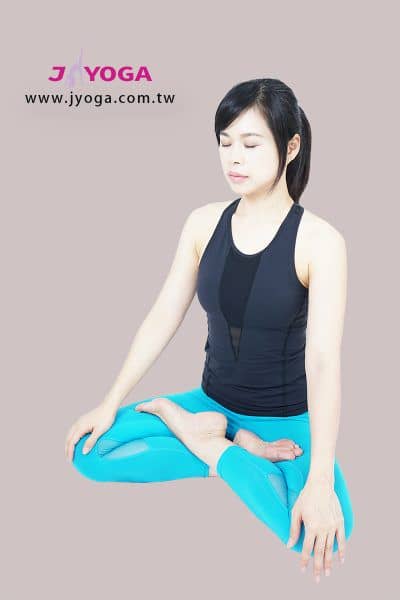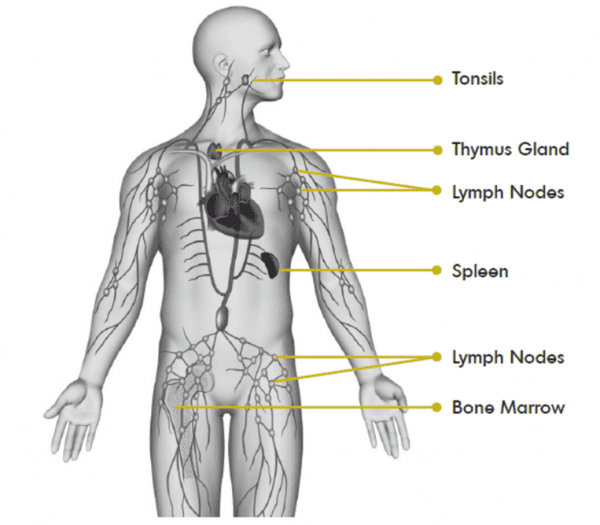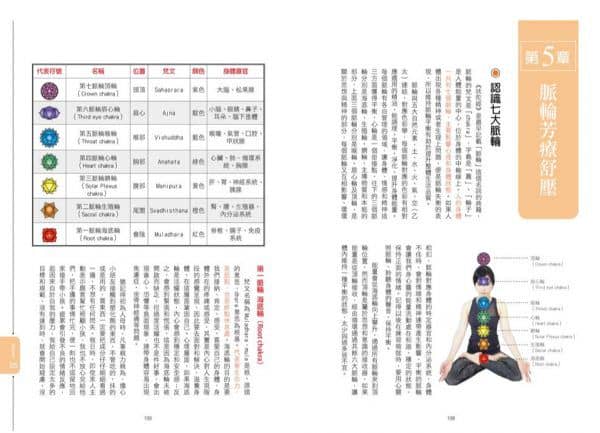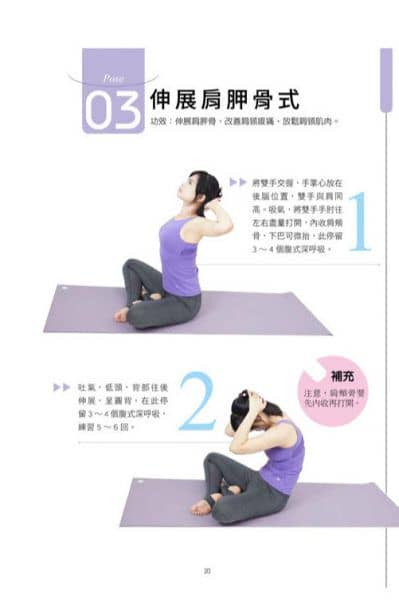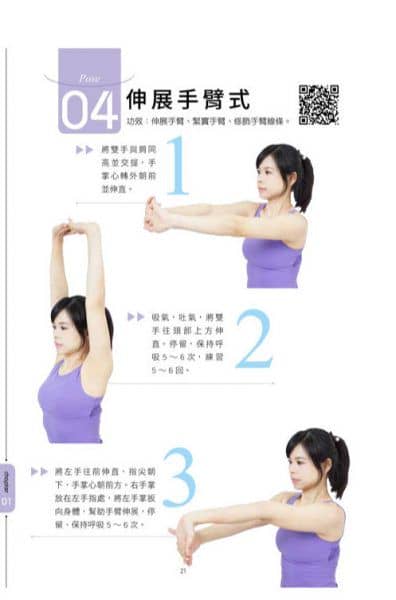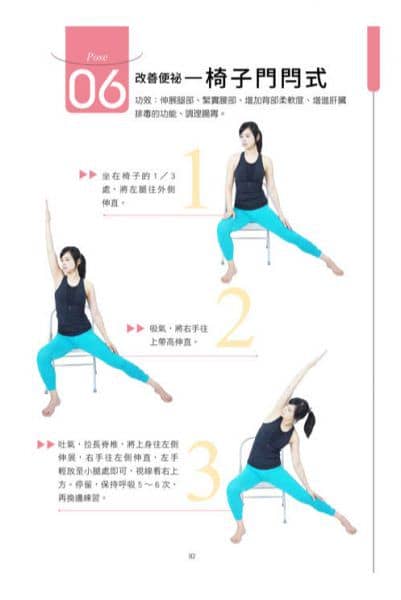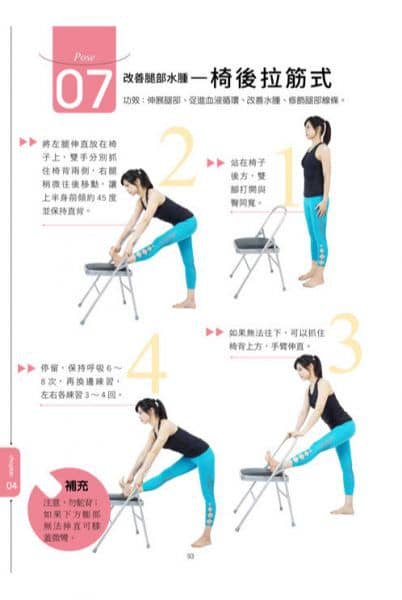現在細菌、病毒百百種,真正能夠對抗病毒的只有提升自我的免疫力~
這次的武漢肺炎(COVID-19, 新型冠狀病毒)疫情從小年夜開始至今已造成恐慌,口罩、酒精消毒用品
造成搶購,口罩在有錢買不到下,政府實施配給方式購買,全球經濟也受到影響~
看到視頻專訪一些得到武漢肺炎病癒和醫師建議如何預防的建議之道,治癒共同的之處
就是靠自我的免疫力去對抗病毒,有家長的小朋友應該都知道腸病毒,小朋友不幸得到腸
病毒時,醫師會回覆此時是採用支持療法,靠自我的免疫力對抗病毒,免疫系統的重要性
好像都要在生病時才會受到人的重視~
研究發現每天規律、適度的運動(不建議劇烈運動)是可以提高免疫力、新陳代謝,預防疾病
和維持體態等益處。
飲食方面,多食蔬果(綠色蔬菜、番茄、芒果、奇異果、木瓜、地瓜、玉米、菇類等)、攝取優質
蛋白質、補充維生素B群和礦物質食物(全榖雜糧)、乳製品等。
免疫系統有三道防線,完整的守護我們的身體~
非特異性免疫 Innate immunity
第一道防線:
皮膚、黏膜,主要功能:阻擋和殺死病原體
第二道防線:
發炎反應、吞噬細胞、保護性蛋白質(補體、干擾素),主要功能:溶解、吞噬病菌
特異性免疫 adaptive immunity
第三道防線:
體液免疫、細胞免疫,主要功能:產生抗體、清除病原體
免疫(immunity)-免除瘟疫,是人體自身的防禦機制,指機體接觸到「抗原性異物」或
「異己成分」時的特異生理反應。
「抗原性異物」-人體識別和消滅外來侵入的任何異物(病毒、細菌等)
「異己成分」-識別和處理體內突變細胞和病毒感染細胞的能力。
免疫力可分為:
非特異性免疫 Innate immunity(先天免疫系統):人一生下來就有。
特異性免疫 adaptive immunity (後天免疫系統):人生下來以後在生活環境過程中得到。
免疫機制功能會在30歲左右開始下降。
免疫系統組成:
免疫器官-脾臟、骨髓、胸腺、淋巴結、扁桃體等
免疫細胞-淋巴細胞、吞噬細胞、中性粒細胞、肥大細胞等
免疫分子-補體、免疫球蛋白、白細胞介素等組成。
免疫系統的平衡就像瑜珈的7大脈輪所注重的平衡一樣,過多、過少皆不適宜,
2020年2/12上市 我的新書-辦公室舒壓塑身瑜伽 有寫到瑜珈脈輪的部分和對應的腺體。
當身體免疫力過高會出現異常反應,也就是大家知道的「過敏」,對身體外部的物質
反應過度,例如:過敏性哮喘、鼻炎、蕁麻疹、食物過敏等狀況,嚴重點就是對自己
的組織細胞產生反應,像是:類風性關節炎、紅斑性狼瘡、惡性貧血等。
免疫力低下,身體無法發揮保護機制時,此時會很容易生病,體質變虛弱、精神變差、
睡眠障礙等,如果是小朋友的話還會影響智力的發展。
常會聽到練習瑜珈會提升免疫力和眾多益處,是真的嗎?現在就來看以下國外的研究報導吧!
這是一個瑜珈平衡的研究,有幫助或未幫助都說明。
看完後,趕快來練習瑜珈吧~ :-D
資料來源:美國 國立衛生研究院 美國衛生與公共服務部
(National Center for Complementary and Integrative Health (NCCIH))
標題 →瑜伽:您需要知道的
什麼是瑜伽,它如何運作?
瑜伽是古老而復雜的練習,其根源於印度哲學。 它起初是一種精神修行,但已逐漸流行為促
進身心健康的一種方式。
儘管古典瑜伽也包含其他元素,但在美國練習的瑜伽通常強調身體姿勢( asanas ),呼吸技巧
( pranayama )和冥想( dyana )。 諸如艾揚格(Iyengar),畢克藍(Bikram)和哈達
(hatha)瑜伽之類的流行瑜伽風格都集中在這些元素上。
瑜伽和兩種中國血統-太極拳和氣功-有時被稱為“冥想運動”。
這三種練習都包括冥想元素和身體因素。
瑜伽對健康有什麼好處?
研究表明,瑜伽可以:
- 通過減輕壓力,維持良好的健康習慣以及改善心理/情感健康,睡眠和平衡來幫助改善總體健康
- 緩解腰痛和肩頸痠痛
- 緩解更年期症狀
- 幫助人們管理因生活困難狀況相關的焦慮或抑鬱症狀(但尚未證明瑜伽可以幫助管理焦慮症,臨床抑鬱症或創傷後應激障礙[PTSD])
- 幫助人們戒菸
- 幫助超重或肥胖的人減肥
- 幫助患有慢性疾病的人控制症狀並改善生活品質。
儘管人們對瑜伽的健康影響進行了大量研究,但許多研究僅涉及少量人群,而且質量不高。
因此,在大多數情況下,我們只能說瑜伽已經顯示出對特定健康用途的希望,還未證明它的幫助作用。
關於瑜伽健身的研究表明了什麼?
研究表明瑜伽對健康的多個方面可能有好處,包括壓力管理,心理/情緒健康,促進健康的飲食/活動習慣,
睡眠和平衡。
- 壓力管理。 在最近的一項評論中,瑜伽的17項研究(1,070名參與者)涉及壓力管理,其中12項研究表明與壓力有關的身體或心理指標有所改善。
- 精神/情緒健康。 在最近對14項研究(1,084名參與者)進行的評估中,評估了瑜伽對心理健康的積極方面的影響,其中10項研究發現了有益的證據,例如提高了復原力或總體心理健康。
- 促進健康的飲食/活動習慣。 2018年對年輕人的調查(涉及1,820名參與者)表明,定期練習瑜伽與更好的飲食和體能鍛煉習慣有關。 在接受采訪的人中,接受調查的人說,他們認為瑜伽可提高正念,養成更健康習慣以及一個健康的瑜伽社區。
- 睡覺。 在對癌症患者和老年人的多項研究以及在其他人群(包括患有關節炎的人,孕婦和更年期症狀的婦女)的個人研究中,瑜伽已被證明有助於睡眠。
- 平衡。 在15項研究中(總計688名參與者),研究了瑜伽對健康人平衡的影響,其中11項顯示至少一項與平衡有關的結果有所改善。
瑜伽可以幫助緩解疼痛嗎?
已經針對涉及疼痛的幾種情況進行了瑜伽方面的研究。 瑜伽對腰背痛和頸部疼痛的研究取得了進一步結果,
瑜伽是美國醫師學院推薦用於慢性腰背痛的一線治療的選擇之一。 關
於頭痛,關節炎或纖維肌痛的瑜伽方面的研究很少,因此尚不確定它能否幫助緩解這些狀況的疼痛。
- 腰背疼痛。
衛生保健研究與質量機構(AEA)於2018年發布的一份報告評估了8項關於腰背痛的瑜伽研究(涉及1,466名參與者),發現瑜伽在短期(1至6個月)和中期(無論是短期還是中期)均改善了疼痛和功能( 6至12個月)。 瑜伽的效果類似於運動。
美國內科醫學院建議使用非藥物方法來治療慢性下腰痛。 瑜伽是幾種建議的非藥物治療方法之一。
- 頸部疼痛。 2019年對10項研究(總共686名參與者)進行的審查發現,練習瑜伽既可以減輕頸部疼痛的強度和與頸部疼痛相關的殘疾,又可以改善頸部的運動範圍。
- 頭痛 關於頭痛瑜伽的研究很少。 2015年嘗試審查有關此主題的研究,結果發現只有1項研究有72名參與者可以評估。 這項研究取得了令人滿意的結果,頭痛強度和頻率降低了,但一項研究並沒有太多證據。
- 關節炎和纖維肌痛。 瑜伽對關節炎或其他與關節痛有關的疾病的研究還很少。 2013年的一項評估發現,只有8項研究可以評估:骨關節炎3例(304名參與者),類風濕性關節炎2例(110名參與者),纖維肌痛2例(96名參與者)和腕管綜合症1例(51名參與者)。 研究表明,除了腕隧道症候群外,在所有情況下疼痛可能有益的證據很少,因為腕隧道症候群的數據不足以提出任何建議。
瑜伽是減肥的好方法嗎?
有證據表明瑜伽可以幫助人們減肥。 2013年,NCCIH支持的一項審查對17種基於瑜伽的體重控制計
劃進行了研究,結果發現其中大多數導致體重逐漸,適度降低。 結果最好的程序至少包含以下一些元素:
- 更長更頻繁的瑜伽課
- 整個課程時間更長
- 瑜伽為基礎的飲食成分
- 居住部分(例如整個週末開始該計劃)
- 瑜伽的更多要素
- 居家練習。
2016年的另一篇評論研究了針對超重或肥胖個體的10項瑜伽研究,發現練習瑜伽與體重指數降低(
BMI;基於身高和體重的身體脂肪測量)有關。
瑜伽可以幫助您戒菸嗎?
有證據表明瑜伽可以幫助人們戒菸。 2014年的一份報告評估了10項研究(484名參與者),
其中測試了基於瑜伽的干預措施以幫助戒菸。 在大多數研究中,瑜伽與減少渴望和減少吸煙量有關。
瑜伽如何影響心理健康?
有證據表明,瑜伽可能有助於緩解與各種生活狀況(例如醫療狀況或壓力性教育計劃)相關的焦慮症,
並有助於緩解抑鬱症狀。 然而,尚未證明瑜伽可以幫助管理經診斷的精神健康狀況,
例如焦慮症,抑鬱症或創傷後壓力症候群。
- 2013年,一項針對23種瑜伽(1,722名參與者)的研究對生活狀況相關的焦慮進行了評估,其中瑜伽似乎在某些情況下有所幫助,而在另一些情況下則無濟於事。 一般而言,對於至少進行10次瑜伽練習的干預措施,效果會更好。 這些研究的品質中等至較差,因此無法得出有關瑜伽效果的明確結論。
- 2018年對8項關於焦慮症的瑜伽研究進行了審查(319名焦慮症患者或焦慮水平升高的參與者),發現證據表明瑜伽在減輕焦慮強度方面可能具有短期益處。 但是,當分析中僅包括診斷出焦慮症的人時,沒有發現瑜伽的有益作用。
- 在最近對有抑鬱症狀(雖然不一定診斷出患有抑鬱症)的人的23項研究(1,272名參與者)的評論中,瑜伽有助於減輕14項研究的症狀。
- 2017年對7項研究(240名參與者)進行了回顧,研究了對被診斷患有抑鬱症的人進行瑜伽干預的情況。 它發現了一些有益效果的證據,但審閱者認為證據不足以為這種情況的人推薦瑜伽。 問題包括研究的人數少,以及由於缺乏足夠的安全信息而無法將收益與風險進行比較。
- 2017年對7項針對創傷後壓力症候群(PTSD)的瑜伽研究(284名參與者)的評估發現,只有一些低數據可能會帶來好處。
瑜伽可以幫助解決更年期症狀嗎?
瑜伽似乎在緩解更年期症狀方面至少與其他類型的鍛煉同樣有效。
2018年對13項關於更年期症狀的瑜伽研究(超過1,300名參與者)的評估發現,
瑜伽可以減輕身體症狀,例如潮熱以及心理症狀。
瑜伽對慢性病患者有幫助嗎?
有希望的證據表明,瑜伽可以幫助患有某些慢性疾病的人控制症狀並改善生活品質。
因此,它可能是治療方案的有益補充。
- 癌症:
在2018年對138種關於在各種類型的癌症患者中使用瑜伽的研究的評估(總共10,660名參與者)中,
大多數研究發現瑜伽可以改善患者的身體和心理症狀以及生活品質。
許多瑜伽研究的重點是乳腺癌患者和倖存者。 2017年,一項針對24位乳腺癌女性研究的研究
(總共超過2,100名參與者)發現,中間數據的證據表明瑜伽有助於減輕疲勞和睡眠障礙,
並改善與健康相關的生活品質。 瑜伽的效果類似於其他類型的運動,並且效果優於教育課程。
- 多發性硬化症。
2014年對7項研究(670名參與者)進行的審查發現,瑜伽對多發性硬化症患者的疲勞和情緒有
短期益處,但不會影響肌肉功能,認知功能或生活品質。 瑜伽對疲勞的影響與其他運動類似。
慢性阻塞性肺疾病(COPD)。 2018年對10項研究(總共502名參與者)的分析發現,
瑜伽可以改善COPD患者的身體能力(例如能夠在規定的時間內行走一定的距離),肺功能和生活品質的證據。
- 哮喘
2016年,一項針對哮喘的15項瑜伽研究研究(1,048名參與者)得出結論,瑜伽可能能改善生活
品質和症狀。額外的瑜伽健康方法絕不能取代哮喘的醫療方式。
瑜伽有什麼風險?
在合格的教練的指導下,大家都知道正確地練習瑜伽是一種安全方式。
但是,與其他形式的體能鍛煉一樣,有可能會發生傷害。 最常見的傷害是扭傷和拉傷。
嚴重傷害很少見。 與瑜伽相關的傷害風險低於對身體有較大影響的體能鍛煉。
老年人練習瑜伽時可能需要特別小心。 在65歲及65歲以上的老年人中,急診科接受瑜伽相關傷害
的比例高於年輕人。
為了減少做瑜伽時受傷的機會:
- 在合格的教練的指導下練習瑜伽。
- 如果您是瑜伽新手,請避免使用極端的做法,例如倒立、肩立式、蓮花雙盤姿勢和強力呼吸。
- 請注意,Bikram瑜伽(“熱瑜伽”)具有與過熱和脫水相關的特殊風險。
(10幾年前熱瑜珈在台灣風行一陣子,每間會館都會把教室溫度調高至40-41度左右,
也就是你還未練習瑜珈時就已經滿身大汗,就像處在三溫暖烤箱一樣,失去瑜珈的
本意,練習瑜珈應該是靠練習時產生的熱能而不是靠外部改變過的環境)
- 孕婦,老年人和有健康狀況的人應與他們的醫師和瑜伽教練談談他們的個人需求。 他們可能需要避免或改變一些瑜伽姿勢和做法。
如何成為一位合格的瑜珈老師?
瑜伽在美國有多受歡迎?
根據2017年的一項全國調查,在過去的12個月中,約有七分之一的美國成年人練習瑜伽。
在4至17歲的兒童中,這一比例約為12分之一。從2007年至2012年,從2012年至2017年,
瑜伽練習者的比例有所增加。成人和兒童均是如此。
美國人為什麼練習瑜伽?
2012年的國家調查數據顯示,練習瑜伽的成年人中有94%是出於與健康相關的原因而做瑜伽的,
而有17.5%的成年人是為了治療特定的健康狀況而做瑜伽的。 這些數字加起來超過100%,
因為有人報告說兩者都做。
大多數練習瑜伽的成年人說,瑜伽通過以下與健康相關的方式提供幫助:
86%的人說它減輕了壓力
67%的人說這有助於他們在情緒上感覺更好
63%的人說這激勵他們更多地運動
59%的人說它改善了睡眠
82%的人說它改善了整體健康,並使他們感覺更好。
少數人報告了其他好處:
43%的人說瑜伽促使他們飲食更健康
39%的人說瑜伽可以緩解健康問題
當前抽煙的人中有25%的人說瑜伽能促使他們減少或停止抽煙
當前飲酒的人中有12%的人說瑜伽能促使他們減少或停止飲酒。
不同的人群會有不同的瑜伽經驗嗎?
美國大部分的瑜伽研究都是在人群中進行的,主要是女性,非西班牙裔白人,
受過良好教育,收入相對較高的人群。 在瑜伽研究中,其他人
(尤其是少數群體的成員和收入較低的人)的代表性不足。
不同的人群可能有與瑜伽相關的不同經驗。
與年齡有關的差異。 在一項調查中,中年人更有可能練習瑜伽以增加肌肉力量或減輕體重,
而老年人則有更多動機是與年齡有關的慢性健康問題。 如前所述,老年人也可能更需要因瑜伽
相關傷害而接受治療。
與教育有關的差異。 全國調查數據表明,無論是在普通人群中還是在腰背痛患者中,“知識匱乏”
在報告中為文化程度較低的人比文化程度較高的人不練習瑜伽的原因。
與性別有關的差異。 一項研究發現,在特定的瑜伽姿勢對肌肉的影響上,男女之間存在差異。
一項對退伍軍人的研究發現,初步證據表明,通過瑜伽治療慢性背痛,女性可能比男性受益更多。
國家補充與綜合健康中心(NCCIH)資助的研究
NCCIH贊助的研究正在調查瑜伽在多種情況下的影響,包括:
廣泛性焦慮症
接受化療的癌症患者的睡眠障礙和疲勞
青少年抑鬱症
退伍軍人的慢性疼痛。
更多考慮
不要使用瑜伽來推遲就醫療問題向醫療保健提供者諮詢。
詢問您正在考慮的瑜伽教練的培訓和經驗。
負責您的健康-與您的醫療保健提供者討論您使用的任何補充性健康方法。
您可以共同製定明智的共享決策。
PubMed®是國家醫學圖書館的一項服務,其中包含出版物信息和(在大多數情況下)科學和醫學期刊
文章的簡短摘要。 有關NCCIH使用PubMed的指導,請參閱如何在PubMed上查找有關補充健康方法的信息 。
網站:
www.ncbi.nlm.nih.gov/pubmed
關鍵參考
Black LI,Barnes PM,Clarke TC,Stussman BJ,Nahin RL。 在美國4-17歲的兒童中使用瑜伽,冥想和按摩師 。
NCHS數據簡介,第324號。馬里蘭州凱茲維爾:國家衛生統計中心。 2018。
Clarke TC,Barnes PM,Black LI,Stussman BJ,Nahin RL。 在18歲以上的美國成年人中使用瑜伽,
冥想和按摩師 。 NCHS數據簡介,第325號。馬里蘭州凱悅維爾:國家衛生統計中心。 2018。
Cramer H,Anheyer D,Lauche R等。 瑜伽對重度抑鬱症的系統評價。 情感障礙雜誌 。 2017; 213:70-77。
Cramer H,Krucoff C,Dobos G. 與瑜伽相關的不良事件:對已發表病例報告和病例係列的系統評價 。 一號 。 2013; 8(10):e75515。
Cramer H,Lauche R,Anheyer D等。 瑜伽焦慮症:隨機對照試驗的系統評價和薈萃分析 。 抑鬱和焦慮 。 2018; 35(9):830-843。
Cramer H,Lauche R,Klose P等。 瑜伽可改善被診斷患有乳腺癌的女性的健康相關生活品質,心理健康和癌症相關症狀 。
Cochrane系統評價數據庫 。 2017;(1):CD010802。 於2018年6月7日訪問www.cochranelibrary.com 。
Cramer H,Ostermann T,Dobos G. 與瑜伽練習相關的傷害和其他不良事件:流行病學研究的系統綜述 。
體育科學與醫學雜誌。 2018; 21(2):147-154。
Cramer H,Ward L,Saper R等。 瑜伽的安全性:對隨機對照試驗的系統評價和薈萃分析 。
美國流行病學雜誌 。 2015; 182(4):281-293。
多明格斯RB。 現代姿勢瑜伽作為一種促進心理健康的工具:系統綜述。
臨床實踐中的輔助治療 。 2018; 31:248-255。
Li Y,Li S,Jiang J等。 瑜伽對慢性非特異性頸部疼痛患者的影響。 PRISMA系統評價和薈萃分析。
醫學 。 2019; 98(8):e14649。
Qaseem A,Wilt TJ,McLean RM等。 急性,亞急性和慢性下腰痛的非侵入性治療:美國醫師學院的臨
床實踐指南 。 內科醫學年鑑。 2017; 166(7):514-530。
Rioux JG,Ritenbaugh C. 對瑜伽干預臨床試驗的敘述性評論,包括與體重相關的結果 。
健康和醫學的替代療法。 2013; 19(3):32-46。
Skelly AC,Chou R,Dettori JR等。 慢性疼痛的非侵入性非藥物治療:系統評價 。
比較效果審查編號 209.馬里蘭州羅克維爾:衛生保健研究與質量局;
2018.AHRQ出版物編號 18-EHC013-EF。
Swain TA,McGwin G. 2001年至2014年在美國與瑜伽相關的傷害 。
骨科運動醫學 。 2016; 4(11):2325967116671703。
原文
Yoga: What You Need To Know
What is yoga and how does it work?
Yoga is an ancient and complex practice, rooted in Indian philosophy.
It began as a spiritual practice but has become popular as a way of promoting physical
and mental well-being.
Although classical yoga also includes other elements, yoga as practiced in the
United States typically emphasizes physical postures (asanas), breathing
techniques (pranayama), and meditation (dyana). Popular yoga styles
such as iyengar, bikram, and hatha yoga focus on these elements.
Yoga and two practices of Chinese origin—tai chi and qi gong—are sometimes
called “meditative movement” practices. All three practices include both
meditative elements and physical ones.
What are the health benefits of yoga?
Research suggests that yoga may:
Help improve general wellness by relieving stress, supporting good health habits,
and improving mental/emotional health, sleep, and balance
Relieve low-back pain and neck pain
Relieve menopause symptoms
Help people manage anxiety or depressive symptoms associated with difficult life situa
tions (but yoga has not been shown to help manage anxiety disorders, clinical
depression, or posttraumatic stress disorder [PTSD])
Help people quit smoking
Help people who are overweight or obese lose weight
Help people with chronic diseases manage their symptoms and improve their quality of life.
Although there’s been a lot of research on the health effects of yoga, many studies
have included only small numbers of people and haven’t been of high quality.
Therefore, in most instances, we can only say that yoga has shown promise for particular
health uses, not that it’s been proven to help.
What does research show about yoga for wellness?
Studies have suggested possible benefits of yoga for several aspects of wellness,
including stress management, mental/emotional health, promoting
healthy eating/activity habits, sleep, and balance.
Stress management. Of 17 studies (involving 1,070 total participants) of
yoga for stress management included in a recent review, 12 showed
improvements in physical or psychological measures related to stress.
Mental/emotional health. In a recent review of 14 studies
(involving 1,084 total participants) that assessed the effects of yoga on
positive aspects of mental health, 10 studies found evidence of benefits,
such as improvements in resilience or general mental well-being.
Promoting healthy eating/activity habits. A 2018 survey of young adults
(involving 1,820 participants) showed that practicing yoga regularly
was associated with better eating and physical activity habits. In interviews,
people who took the survey said they thought yoga supported
healthier habits through greater mindfulness, motivation to participate in
other forms of activity and eat healthier, and the influence of
a health-minded yoga community.
Sleep. Yoga has been shown to be helpful for sleep in several studies
of cancer patients and older adults and in individual studies in
other population groups, including people with arthritis, pregnant women,
and women with menopause symptoms.
Balance. Of 15 studies (688 total participants) looking at the effect of yoga
on balance in healthy people, 11 showed improvements in at least one
outcome related to balance.
Can yoga help with pain management?
Research has been done on yoga for several conditions that involve pain.
Studies of yoga for low-back pain and neck pain have had promising results,
and yoga is among the options that the American College of Physicians
recommends for first-line treatment of chronic low-back pain.
Very little research has been done on yoga for headaches, arthritis, or
fibromyalgia, so it’s uncertain whether it can help to relieve pain from these conditions.
Low-back pain.
A 2018 report by the Agency for Healthcare Research and Quality evaluated
8 studies of yoga for low-back pain (involving 1,466 total participants) and
found that yoga improved pain and function in both the short term (1 to 6 months)
and intermediate term (6 to 12 months). The effects of yoga were similar to those of exercise.
The American College of Physicians recommends using nondrug methods for the initial
treatment of chronic low-back pain. Yoga is one of several suggested nondrug approaches.
Neck pain. A 2019 review of 10 studies (686 total participants) found that practicing
yoga reduced both the intensity of neck pain and disability related to neck pain and
improved range of motion in the neck.
Headaches. Very little research has been done on yoga for headaches.
A 2015 attempt to review the research on this topic found only 1 study with 72
participants that could be evaluated. That study had favorable results, with decreases
in headache intensity and frequency, but one study is not much evidence.
Arthritis and fibromyalgia. There hasn’t been much research on yoga for arthritis
or other conditions associated with joint pain. A 2013 evaluation found only 8 studies
that could be evaluated: 3 on osteoarthritis (304 participants), 2 on rheumatoid
arthritis (110 participants), 2 on fibromyalgia (96 participants), and 1 on carpal
tunnel syndrome (51 participants). The studies showed weak evidence of
a possible benefit for pain in all of the conditions except carpal tunnel syndrome,
for which the data were insufficient for any recommendation to be made.
Is yoga a good way to lose weight?
There’s evidence that yoga may help people lose weight. In 2013,
an NCCIH-supported review looked at 17 yoga-based weight control programs and
found that most of them led to gradual, moderate reductions in weight.
The programs with the best results included at least some of these elements:
Longer and more frequent yoga sessions
A longer duration of the overall program
A yoga-based dietary component
A residential component (such as a full weekend to start the program)
A larger number of elements of yoga
Home practice.
Another review, in 2016, looked at 10 studies of yoga in overweight or obese individuals
and found that practicing yoga was associated with reduced body mass index
(BMI; a measure of body fat based on height and weight).
Can yoga help you quit smoking?
There’s evidence that yoga may help people stop smoking. A 2014 report evaluated
10 studies (484 participants) in which yoga-based interventions were tested as an
aid to smoking cessation. In most of the studies, yoga was associated with reduced
cravings and a reduction in the number of cigarettes smoked.
How does yoga affect mental health?
There’s evidence that yoga may be helpful for anxiety associated with various life
situations, such as medical conditions or stressful educational programs,
and for depressive symptoms. However, yoga hasn’t been shown to help in managing
diagnosed mental health conditions such as anxiety disorder, depression, or PTSD.
In a 2013 review of 23 studies (involving 1,722 participants) of yoga for anxiety associated
with life situations, yoga seemed to be helpful in some instances but not others.
In general, results were more favorable for interventions that included at least
10 yoga sessions. The studies were of medium to poor quality, so definite conclusions
about yoga’s effectiveness couldn’t be reached.
A 2018 review of 8 studies of yoga for anxiety (involving 319 participants with anxiety
disorders or elevated levels of anxiety) found evidence that yoga might have short-term
benefits in reducing the intensity of anxiety. However, when only people with
diagnosed anxiety disorders were included in the analysis, no beneficial effects
of yoga were found.
In a recent review of 23 studies (involving 1,272 participants) in people with
depressive symptoms (although not necessarily diagnosed with depression),
yoga was helpful in reducing symptoms in 14 of the studies.
A 2017 review of 7 studies (involving 240 participants) looked at yoga
interventions in people who had been diagnosed with depression.
It found some evidence of beneficial effects, but the reviewers judged the
evidence to be insufficient to justify recommending yoga for people
with this condition. Problems included the small number of people studied
and an inability to compare benefits with risks because of inadequate
information on safety.
A 2017 evaluation of 7 studies (involving 284 participants) of yoga for
people with posttraumatic stress disorder (PTSD) found only low-quality
evidence of a possible benefit.
Can yoga help with menopause symptoms?
Yoga seems to be at least as effective as other types of exercise in relieving
menopause symptoms. A 2018 evaluation of 13 studies
(more than 1,300 participants) of yoga for menopause symptoms found
that yoga reduced physical symptoms, such as hot flashes, as well as
psychological symptoms.
Is yoga helpful for people with chronic diseases?
There’s promising evidence that yoga may help people with some chronic
diseases manage their symptoms and improve their quality of life. Thus,
it could be a helpful addition to treatment programs.
Cancer
In a 2018 evaluation of 138 studies on the use of yoga in patients with various types
of cancer (10,660 total participants), most of the studies found that yoga improved
patients’ physical and psychological symptoms and quality of life.
Many yoga studies have focused on breast cancer patients and survivors.
A 2017 review of 24 studies in women with breast cancer (more than 2,100
total participants) found moderate-quality evidence that yoga helped reduce
fatigue and sleep disturbances and improved health-related quality of life.
The effects of yoga were similar to those of other types of exercise and better
than those of educational programs.
Multiple sclerosis. A 2014 review of 7 studies (involving 670 participants)
found evidence that yoga had short-term benefits on fatigue and mood in
people with multiple sclerosis, but it didn’t affect muscle function, cognitive
function, or quality of life. The effects of yoga on fatigue were similar to those
of other kinds of exercise.
Chronic obstructive pulmonary disease (COPD). A 2018 analysis of 10
studies (502 total participants) found evidence that yoga can improve
physical ability (such as being able to walk a defined distance in a defined time),
lung function, and quality of life in people with COPD.
Asthma
A 2016 review of 15 studies of yoga for asthma (involving 1,048 total participants)
concluded that yoga probably leads to small improvements in quality of life and
symptoms.
Complementary health approaches such as yoga should never be used as a
substitute for medical treatment for asthma.
What are the risks of yoga?
Yoga is generally considered a safe form of physical activity for healthy people
when performed properly, under the guidance of a qualified instructor.
However, as with other forms of physical activity, injuries can occur.
The most common injuries are sprains and strains. Serious injuries are rare.
The risk of injury associated with yoga is lower than that for higher impact
physical activities.
Older people may need to be particularly cautious when practicing yoga.
The rate of yoga-related injuries treated in emergency departments is higher
in people age 65 and older than in younger adults.
To reduce your chances of getting hurt while doing yoga:
Practice yoga under the guidance of a qualified instructor.
If you’re new to yoga, avoid extreme practices such as headstands,
shoulder stands, the lotus position, and forceful breathing.
Be aware that bikram yoga (“hot yoga”) has special risks related to
overheating and dehydration.
Pregnant women, older adults, and people with health conditions should
talk with their health care providers and the yoga instructor about their
individual needs. They may need to avoid or modify some yoga poses and practices.
How popular is yoga in the United States?
About one in seven U.S. adults practiced yoga in the past 12 months, according to a
2017 national survey. Among children age 4 to 17, it was about 1 in 12. The percentage
of people who practice yoga grew from 2007 to 2012 and again from 2012 to 2017.
This was true for both adults and children.
Why do Americans practice yoga?
National survey data from 2012 showed that 94 percent of adults who practiced
yoga did it for wellness-related reasons, while 17.5 percent did it to treat a specific
health condition. The numbers add up to more than 100 percent because some
people reported doing both.
The majority of adults who practiced yoga said that it helped in these wellness-related
ways:
86 percent said it reduced stress
67 percent said it helped them feel better emotionally
63 percent said it motivated them to exercise more regularly
59 percent said it improved sleep
82 percent said it improved overall health and made them feel better.
Smaller numbers of people reported other benefits:
43 percent said yoga motivated them to eat healthier
39 percent said yoga eased coping with health problems
25 percent of people who currently smoke cigarettes said yoga motivated them to
cut back or stop smoking cigarettes
12 percent of people who currently drink alcohol said yoga motivated them to
cut back or stop drinking alcohol.
Do different groups of people have different experiences with yoga?
Much of the research on yoga in the United States has been conducted in populations
similar to those among whom yoga is most popular—that is, predominantly female,
non-Hispanic white, well-educated people with relatively high incomes.
Other people—particularly members of minority groups and those with lower
incomes—have been underrepresented in yoga studies.
Different groups of people may have different yoga-related experiences.
Differences related to age. In one survey, middle-aged people were more likely to
be motivated to practice yoga to increase muscle strength or lose weight, while older
adults were more likely to be motivated by age-related chronic health issues.
As mentioned earlier, older people may also be more likely to need treatment for
yoga-related injuries.
Differences related to education. National survey data indicate that “lack of knowledge”
is more commonly reported as a reason for not practicing yoga among people with
lower educational attainment than those with greater education, both in the general
population and among people with low-back pain.
Differences related to sex. A study found evidence for differences between men and
women in the effects of specific yoga poses on muscles. And a study in veterans
found preliminary evidence that women might benefit more than men from yoga
interventions for chronic back pain.
Research Funded by the National Center for Complementary and Integrative Health (NCCIH)
NCCIH-sponsored studies are investigating the effects of yoga on a variety of conditions including:
Generalized anxiety disorder
Sleep disturbance and fatigue in cancer patients receiving chemotherapy
Depression in adolescents
Chronic pain in veterans.
More To Consider
Don’t use yoga to postpone seeing a health care provider about a medical problem.
Ask about the training and experience of the yoga instructor you’re considering.
Take charge of your health—talk with your health care providers about any compleme
ntary health approaches you use. Together, you can make shared, well-informed decisions.
Key References
Black LI, Barnes PM, Clarke TC, Stussman BJ, Nahin RL. Use of yoga, meditation,
and chiropractors among U.S. children aged 4–17 years. NCHS Data Brief, no 324.
Hyattsville, MD: National Center for Health Statistics. 2018.
Clarke TC, Barnes PM, Black LI, Stussman BJ, Nahin RL. Use of yoga, meditation,
and chiropractors among U.S. adults aged 18 and older. NCHS Data Brief, no 325.
Hyattsville, MD: National Center for Health Statistics. 2018.
sive disorder. Journal of Affective Disorders. 2017;213:70-77.
Cramer H, Krucoff C, Dobos G. Adverse events associated with yoga:
a systematic review of published case reports and case series. PloS One. 2013;8(10):e75515.
ed controlled trials. Depression and Anxiety. 2018;35(9):830-843.
Cramer H, Lauche R, Klose P, et al. Yoga for improving health-related quality
of life, mental health and cancer-related symptoms in women diagnosed
with breast cancer. Cochrane Database of Systematic Reviews.
2017;(1):CD010802. Accessed at www.cochranelibrary.com (link is external)
on June 7, 2018.
ries and other adverse events associated with yoga practice: a systematic review of
epidemiological studies. Journal of Science and Medicine in Sport. 2018;21(2):147-154.
Cramer H, Ward L, Saper R, et al. The safety of yoga: a systematic review and
meta-analysis of randomized controlled trials. American Journal of Epidemiology.
2015;182(4):281-293.
Domingues RB. Modern postural yoga as a mental health promoting tool:
a systematic review. Complementary Therapies in Clinical Practice. 2018;31:248-255.
Li Y, Li S, Jiang J, et al. Effects of yoga on patients with chronic nonspecific neck pain.
A PRISMA systematic review and meta-analysis. Medicine. 2019;98(8):e14649.
Qaseem A, Wilt TJ, McLean RM, et al. Noninvasive treatments for acute, subacute,
and chronic low back pain: a clinical practice guideline from the American College
of Physicians. Annals of Internal Medicine. 2017;166(7):514-530.
Rioux JG, Ritenbaugh C. Narrative review of yoga intervention clinical
trials including weight-related outcomes. Alternative Therapies in Health
and Medicine. 2013;19(3):32-46.
Skelly AC, Chou R, Dettori JR, et al. Noninvasive Nonpharmacological
Treatment for Chronic Pain: A Systematic Review. Comparative Effectiveness
Review no. 209. Rockville, MD: Agency for Healthcare Research and
Quality; 2018. AHRQ publication no. 18-EHC013-EF.
Swain TA, McGwin G. Yoga-related injuries in the United States from 2001
to 2014. Orthopaedic Journal of Sports Medicine. 2016;4(11):2325967116671703.
